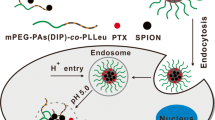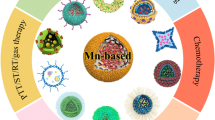Abstract
Magnetic nanoparticles have been used as drug delivery vehicles against a number of cancer cells. Most of these theranostic formulations have used solid iron oxide nanoparticles (SIONPs) loaded with chemotherapeutics as nano-carrier formulation for both magnetic resonance imaging (MRI) and cancer therapy. In this study, we applied the dopamine-plus-human serum albumin (HSA) method to modify hollow iron oxide nanoparticles (HIONPs) and encapsuated doxorubicin (DOX) within the hollow porous structure of the nano-carrier. The new delivery system can load more drug than solid iron oxide nanoparticles of the same core size using the same coating strategy. The HIONPs-DOX formulation also has a pH-dependent drug release behaviour. Compared with free DOX, the HIONPs-DOX were more effectively uptaken by the multidrug resistant OVCAR8-ADR cells and consequently more potent in killing drug resistant cancer cells. MRI phantom and cell studies also showed that the HIONPs-DOX can decrease the T 2 MRI signal intensity and can be used as a MRI contrast agent while acting as a drug delivery vehicle. For the first time, the dual application of chemo drug transport and MR imaging using the HIONPs-DOX formulation was achieved against both DOX-sensitive and DOX-resistant cancer cells.

Similar content being viewed by others
References
Szakács, G.; Paterson, J. K.; Ludwig, J. A.; Booth-Genthe, C.; Gottesman, M. M. Targeting multidrug resistance in cancer. Nat. Rev. Drug Discov. 2006, 5, 219–234.
Kirkin, V.; Joos, S.; Zörnig, M.. The role of Bcl-2 family members in tumorigenesis. Biochim. Biophys. Acta-Mol. Cell Res. 2004, 1644, 229–249.
Kruh, G. D. Introduction to resistance to anticancer agents. Oncogene 2003, 22, 7262–7264.
Calderwood, S. K.; Khaleque, M. A.; Sawyer, D. B.; Ciocca, D. R. Heat shock proteins in cancer: Chaperones of tumorigenesis. Trends Biochem. Sci. 2006, 31, 164–172.
Duhem, C.; Ries, F.; Dicato, M. What Does Multidrug resistance (MDR) expression mean in the clinic. Oncologist 1996, 1, 151–158.
Krishna, R.; Mayer, L. D. Multidrug resistance (MDR) in cancer: Mechanisms, reversal using modulators of MDR and the role of MDR modulators in influencing the pharmacokinetics of anticancer drugs. Eur. J. Pharm. Sci. 2000, 11, 265–283.
Ferry, D. R.; Traunecker, H.; Kerr, D. J. Clinical trials of P-glycoprotein reversal in solid tumours. Eur. J. Cancer 1996, 32A, 1070–1081.
Rowinsky, E. K.; Smith, L.; Wang, Y. M.; Chaturvedi, P.; Villalona, M.; Campbell, E.; Aylesworth, C.; Eckhardt, S. G.; Hammond, L.; Kraynak, M. et al. Phase I and pharmacokinetic study of paclitaxel in combination with biricodar, a novel agent that reverses multidrug resistance conferred by overexpression of both MDR1 and MRP. J. Clin. Oncol. 1998, 16, 2964–2976.
Jabr-Milane, L. S.; van Vlerken, L. E.; Yadav, S.; Amiji, M. M. Multi-functional nanocarriers to overcome tumor drug resistance. Cancer Treat Rev. 2008, 34, 592–602.
Moore, A.; Basilion, J. P.; Chiocca, E. A.; Weissleder, R. Measuring transferrin receptor gene expression by NMR imaging. Biochim. Biophys. Acta-Mol. Cell Res. 1998, 1402, 239–249.
Zhang, Y.; Kohler, N.; Zhang, M. Q.; Surface modification of superparamagnetic magnetite nanoparticles and their intracellular uptake. Biomaterials 2002, 23, 1553–1561.
Ibarz, G.; Dähne, L.; Donath, E.; Möhwald, H. Smart micro- and nanocontainers for storage, transport, and release. Adv. Mater. 2001, 13, 1324–1327.
Zhu, H. G.; McShane, M. J. Loading of hydrophobic materials into polymer particles: Implications for fluorescent nanosensors and drug delivery. J. Am. Chem. Soc. 2005, 127, 13448–13449.
Sukhorukov, G. B.; Antipov, A. A.; Voigt, A.; Donath, E.; Mohwald, H. pH-controlled macromolecule encapsulation in and release from polyelectrolyte multilayer nanocapsules. Macromol. Rapid Comm. 2001, 22, 44–46.
Mamot, C.; Drummond, D. C.; Hong, K.; Kirpotin, D. B.; Park, J. W. Liposome-based approaches to overcome anticancer drug resistance. Drug Resist. Update 2003, 6, 271–279.
Forssen, E. A.; Coulter, D. M.; Proffitt, R. T. Selective in vivo localization of daunorubicin small unilamellar vesicles in solid tumors. Cancer Res. 1992, 52, 3255–3261.
Meng, H.; Liong, M.; Xia, T.; Li, Z. X.; Ji, Z. X.; Zink, J. I.; Nel, A. E. Engineered design of mesoporous silica nano-particles to deliver doxorubicin and P-glycoprotein siRNA to overcome drug resistance in a cancer cell line. ACS Nano 2010, 4, 4539–4550.
You, J.; Zhang, G. D., Li, C. Exceptionally high payload of doxorubicin in hollow gold nanospheres for near-infrared light-triggered drug release. ACS Nano 2010, 4, 1033–1041.
Xiao, Y. L.; Hong, H.; Matson, V. Z.; Javadi, A.; Xu, W. J.; Yang, Y. N,; sZhang, Y.; Engle, J. W.; Nickles, R. J.; Cai, W. B. et al. Gold nanorods conjugated with doxorubicin and cRGD for combined anticancer drug delivery and PET imaging. Theranostics, 2012, 2, 757–768.
Ho, D. N.; Kohler, N.; Sigdel, A.; Kalluri, R.; Morgan, J. R.; Xu, C. J.; Sun, S. H. Penetration of endothelial cell coated multicellular tumor spheroids by iron oxide nanoparticles. Theranostics 2012, 2, 66–75.
Huang, J.; Zhong, X. D.; Wang, L. Y.; Yang, L. L.; Mao, H. Improving the magnetic resonance imaging contrast and detection methods with engineered magnetic nanoparticles. Theranostics 2012, 2, 86–102.
Yu, M. K.; Park, J.; Jon, S. Targeting strategies for multifunctional nanoparticles in cancer imaging and therapy. Theranostics 2012, 2, 3–44.
Xie, J.; Chen, K.; Huang, J.; Lee, S.; Wang, J. H.; Gao, J. H.; Li, X. G.; Chen, X. Y. PET/NIRF/MRI triple functional iron oxide nanoparticles. Biomaterials 2010, 31, 3016–3022.
Quan, Q. M.; Xie, J.; Gao, H. K.; Yang, M.; Zhang, F.; Liu, G.; Lin, X.; Wang, A.; Eden, H. S.; Lee, S. et al. HSA coated iron oxide nanoparticles as drug delivery vehicles for cancer therapy. Mol. Pharmaceut. 2011, 8, 1669–1676.
Gao, J. H.; Liang, G. L.; Cheung, J. S.; Pan, Y.; Kuang, Y.; Zhao, F.; Zhang, B.; Zhang, X. X.; Wu, E. X.; Xu, B. Multifunctional yolk-shell nanoparticles: A potential MRI contrast and anticancer agent. J. Am. Chem. Soc. 2008, 130, 11828–11833.
Xu, C. J.; Xu, K. M.; Gu, H. W.; Zheng, R. K.; Liu, H.; Zhang, X. X.; Guo, Z. H.; Xu, B. Dopamine as a robust anchor to immobilize functional molecules on the iron oxide shell of magnetic nanoparticles. J. Am. Chem. Soc. 2004, 126, 9938–9939.
Peng, S.; Sun, S. S. Synthesis and characterization of monodisperse hollow Fe3O4 nanoparticles. Angew. Chem. Int. Ed. 2007, 46, 4155–4158.
Cheng, K.; Peng, S.; Xu, C. J.; Sun, S. H. Porous hollow Fe3O4 nanoparticles for targeted delivery and controlled release of cisplatin. J. Am. Chem. Soc. 2009, 131, 10637–10644.
Abbasi, S.; Paul, A.; Shao, W.; Prakash, S. Cationic albumin nanoparticles for enhanced drug delivery to treat breast cancer: Preparation and in vitro assessment. J. Drug Deliv., in press, DIO: 10.1155/2012/686108.
Bareford, L. M.; Swaan, P. W. Endocytic mechanisms for targeted drug delivery. Adv. Drug Deliver. Rev. 2007, 59, 748–758.
Tong, R.; Cheng, J. J. Anticancer polymeric nanomedicines. Polym. Rev. 2007, 47, 345–381.
Bhirde, A. A.; Kapoor, A.; Liu, G.; Iglesias-Bartolome, R.; Jin, A.; Zhang, G. F.; Xing, R. J.; Lee, S.; Leapman, R. D.; Gutkind, J. S. et al. Nuclear mapping of nanodrug delivery systems in dynamic cellular environments. ACS Nano 2012, 6, 4966–4972.
Xiong, X. B.; Ma, Z. S.; Lai, R., Lavasanifar, A. The therapeutic response to multifunctional polymeric nano-conjugates in the targeted cellular and subcellular delivery of doxorubicin. Biomaterials 2010, 31, 757–768.
Kievit, F. M.; Wang, F. Y.; Fang, C.; Mok, H.; Wang, K.; Silber, J. R.; Ellenbogen, R. G.; Zhang, M. Q. Doxorubicin loaded iron oxide nanoparticles overcome multidrug resistance in cancer in vitro. J. Control Release 2011, 152, 76–83.
Huang, J.; Bu, L. H.; Xie, J.; Chen, K.; Cheng, Z.; Li, X. G.; Chen, X. Y. Effects of nanoparticle size on cellular uptake and liver MRI with polyvinylpyrrolidone-coated iron oxide nanoparticles. ACS Nano 2010, 4, 7151–7160.
Author information
Authors and Affiliations
Corresponding author
Electronic supplementary material
Rights and permissions
About this article
Cite this article
Xing, R., Bhirde, A.A., Wang, S. et al. Hollow iron oxide nanoparticles as multidrug resistant drug delivery and imaging vehicles. Nano Res. 6, 1–9 (2013). https://doi.org/10.1007/s12274-012-0275-5
Received:
Revised:
Accepted:
Published:
Issue Date:
DOI: https://doi.org/10.1007/s12274-012-0275-5




